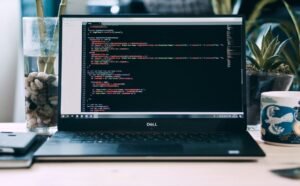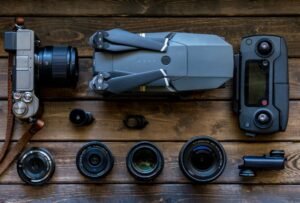Deep Learning as Optimal Control Problems
Deep learning has gained significant popularity in recent years, thanks to its ability to process vast amounts of data and make accurate predictions. However, understanding the fundamental principles behind deep learning and its applications can often be challenging. In this article, we will explore how deep learning can be viewed as optimal control problems, providing a new perspective on this rapidly growing field.
Key Takeaways
- Deep learning can be seen as a form of optimal control, solving problems by finding the best set of actions to maximize a certain objective.
- Optimal control theory provides a mathematical framework to model and solve decision-making problems.
- Reinforcement learning algorithms, such as Q-learning, leverage optimal control principles to train deep learning models.
- By treating deep learning as an optimal control problem, researchers can incorporate prior knowledge and constraints into the learning process.
- This approach opens up new possibilities for designing more interpretable and robust deep learning models.
**Deep learning** algorithms, inspired by the functioning of the **human brain**, consist of artificial neural networks with multiple hidden layers. These networks learn from data through a process known as **training**, where they adjust their parameters to minimize a predefined **loss function**. While traditional machine learning models often rely on handcrafted features, deep learning models automatically learn relevant features from raw data, allowing them to perform complex tasks with less manual intervention. *This ability to automatically learn features contributes to the effectiveness of deep learning algorithms in a wide range of applications.*
Understanding Optimal Control
**Optimal control theory** is a branch of applied mathematics that deals with finding the best set of actions to optimize a given objective, subject to certain constraints. It has found applications in various fields, including engineering, economics, and robotics. By formulating a problem as an optimal control problem, one can mathematically model the decision-making process and use optimization algorithms to find the optimal solution. *This framework allows for precise and efficient decision-making in complex systems.*
**Deep learning** can be seen as an extension of optimal control problems. Instead of trying to find the optimal physical control actions, deep learning models aim to find the best set of parameters for the neural network that maximizes predictive accuracy or minimizes error. This optimization process involves finding the optimal set of weights connecting the network’s neurons through a process known as **backpropagation**. *Through this iterative process of adjusting the parameters, deep learning models gradually improve their performance.*
Applications of Deep Learning as Optimal Control Problems
The use of optimal control principles in deep learning has led to significant advancements in various applications. One prominent example is in the field of **autonomous vehicles**, where deep learning models can learn control policies to navigate through complex environments. These models leverage optimal control techniques to make real-time decisions based on sensor inputs, ensuring safe and efficient driving. *By incorporating optimal control principles, deep learning-based autonomous vehicles can adapt to changing traffic conditions and handle unexpected situations.*
Table 1: Comparison of Deep Learning and Optimal Control
| Deep Learning | Optimal Control |
|---|---|
| Trained using large datasets | Optimized through mathematical modeling |
| Automatic feature learning | Handcrafted feature engineering |
| Focus on prediction accuracy | Focus on finding optimal actions |
Furthermore, deep learning models as optimal control problems have also been applied to **financial forecasting**. These models can learn to optimize trading strategies, portfolio management, and risk assessment by considering parameters such as historical price data, market trends, and risk indicators. *By treating financial decision-making as an optimal control problem, deep learning models can adapt and respond to changing market conditions, potentially improving investment strategies.*
Table 2: Applications of Deep Learning as Optimal Control Problems
| Application | Use |
|---|---|
| Autonomous vehicles | Real-time decision-making |
| Financial forecasting | Trading strategies and risk assessment |
| Robotics | Motion planning and control |
**Researchers** are exploring the potential of combining deep learning with optimal control principles in various other domains. For example, deep learning models have been used in **healthcare** to predict disease outcomes and optimize treatment plans. These models can learn from large datasets of patient records and medical imaging data, providing personalized recommendations for diagnosis and treatment. *By incorporating optimal control techniques, healthcare professionals can make more informed and personalized decisions, resulting in improved patient outcomes.*
Table 3: Deep Learning and Optimal Control in Healthcare
| Application | Use |
|---|---|
| Disease prognosis | Predicting patient outcomes |
| Treatment optimization | Personalized recommendations |
| Image analysis | Aiding diagnosis and detection |
In conclusion, viewing deep learning as optimal control problems opens up new opportunities for designing more interpretable and robust deep learning models. By leveraging the principles of optimal control theory, researchers can incorporate prior knowledge and constraints into the learning process, making deep learning models more adaptable and reliable in various domains. *This interdisciplinary approach further strengthens the potential of deep learning in solving complex decision-making problems and continues to drive advancements in fields ranging from autonomous vehicles to healthcare.*

Common Misconceptions
1. Deep Learning is the same as Optimal Control Problems
One common misconception is that deep learning and optimal control problems are the same thing. While deep learning can be used as a tool to solve optimal control problems, they are not interchangeable terms. Deep learning refers to a subfield of machine learning that focuses on modeling and understanding complex patterns and relationships in data, while optimal control problems are a branch of mathematics concerned with finding the best control strategy for a given system.
- Deep learning is a subset of machine learning
- Optimal control problems involve finding the best control strategy
- Deep learning can be used as a tool to solve optimal control problems
2. Deep Learning always results in optimal solutions
Another common misconception is that deep learning always guarantees optimal solutions. While deep learning algorithms can be powerful and provide accurate predictions, they do not always yield optimal results. The performance of a deep learning model depends on various factors, such as the quality and size of the training data, the choice of model architecture, and the optimization procedure. Therefore, it is important to carefully design and validate deep learning models to ensure their effectiveness.
- Deep learning models do not always guarantee optimal solutions
- Performance depends on factors such as training data and model architecture
- Careful design and validation of deep learning models is necessary
3. Deep Learning can solve all types of Optimal Control Problems
A common misconception is that deep learning can solve any type of optimal control problem. While deep learning has shown promising results in various domains, it is not a one-size-fits-all solution. Different types of optimal control problems require tailored approaches and techniques. Simple optimal control problems with known dynamics and constraints can often be solved through traditional optimization methods, while more complex problems may benefit from the use of deep learning. Understanding the specific problem requirements is crucial for choosing the appropriate approach.
- Deep learning is not a universal solution for all optimal control problems
- Simple problems can be solved through traditional optimization methods
- Complex problems may benefit from the use of deep learning
4. Deep Learning is only applicable to deterministic Optimal Control Problems
There is a misconception that deep learning is only applicable to deterministic optimal control problems. While deep learning can be used in deterministic settings, it is also applicable to stochastic and partially observable optimal control problems. By leveraging the power of deep neural networks, uncertainty and incomplete information can be effectively modeled, leading to improved control strategies in challenging and uncertain environments.
- Deep learning applies to both deterministic and stochastic optimal control problems
- Deep neural networks can model uncertainty and incomplete information
- Improved control strategies can be achieved in uncertain environments
5. Deep Learning is a black-box approach for Optimal Control Problems
Another misconception is that deep learning is a black-box approach for solving optimal control problems. While deep learning models can be complex and often lack interpretability, efforts have been made to improve transparency and understanding. Techniques such as attention mechanisms, model explanation methods, and interpretability tools allow researchers and practitioners to gain insights into the decision-making processes of deep learning models when applied to optimal control problems.
- Deep learning models can lack interpretability
- Techniques like attention mechanisms and model explanation methods improve transparency
- Interpretability tools provide insights into decision-making processes

Overview of Deep Learning Models
Deep learning models have gained popularity in recent years due to their ability to handle complex patterns and large amounts of data. These models use multiple layers of artificial neural networks to process information and make predictions. The following table provides an overview of different types of deep learning models.
| Model | Description | Applications |
|---|---|---|
| Convolutional Neural Networks (CNN) | Specialized for image and video processing, using convolutional layers to extract features. | Computer vision, object recognition, autonomous vehicles. |
| Recurrent Neural Networks (RNN) | Designed for sequential data, using feedback connections to process information over time. | Natural language processing, speech recognition, time-series analysis. |
| Generative Adversarial Networks (GAN) | Consist of a generator and a discriminator network, working together to generate realistic data. | Image and video generation, style transfer. |
| Transformers | Based on self-attention mechanism, capturing dependencies between different positions in a sequence. | Machine translation, text generation, language understanding. |
Comparison of Deep Learning and Traditional Machine Learning
Compared to traditional machine learning algorithms, deep learning offers unique advantages in handling complex tasks and extracting intricate patterns from data. The following table highlights the differences between deep learning and traditional machine learning.
| Deep Learning | Traditional Machine Learning | |
|---|---|---|
| Data Requirements | Large amounts of labeled data. | Relatively smaller labeled data. |
| Feature Extraction | Automatic feature extraction from raw data. | Manual feature engineering required. |
| Model Complexity | Deeper architectures with numerous parameters. | Shallower models with fewer parameters. |
| Performance | Higher accuracy on complex tasks. | Good performance on smaller and structured problems. |
Optimal Control Approaches in Deep Learning
Recent research has explored the connections between deep learning and optimal control problems, aiming to enhance the understanding and performance of deep learning models. The following table showcases the different approaches integrating optimal control in deep learning.
| Approach | Description | Benefits |
|---|---|---|
| Proximal Policy Optimization (PPO) | Uses optimal control techniques to optimize reinforcement learning policies. | Stable training, improved sample efficiency. |
| Pontryagin’s Minimum Principle | Applies optimal control theory to guide the learning process in deep neural networks. | Enhances model interpretability, better convergence. |
| Path Integral Control | Estimates optimal control paths in deep recurrent neural networks. | Improved control over agent behavior, enhanced performance. |
Applications of Deep Learning as Optimal Control Problems
The integration of deep learning and optimal control problems has led to advancements in various domains. The table below presents notable applications of deep learning as optimal control problems.
| Application | Description | Results |
|---|---|---|
| Autonomous Vehicles | Utilizes deep learning for optimal control of vehicle behavior and decision-making. | Improved navigation accuracy, enhanced safety measures. |
| Robotics | Employs deep learning and optimal control to enhance robot motion planning and control in complex environments. | Increased flexibility and adaptability, efficient obstacle avoidance. |
| Finance | Applies deep learning as an optimal control problem for stock trading and portfolio management. | Higher returns, risk mitigation. |
Challenges in Deep Learning as Optimal Control Problems
While the integration of deep learning and optimal control presents numerous advantages, it also comes with its own set of challenges. The following table illustrates some of the challenges faced in this field.
| Challenge | Description |
|---|---|
| Curse of Dimensionality | As the number of control variables increases, the computational complexity grows exponentially. |
| Robustness | Deep learning models may struggle in adapting to slight variations or inaccuracies in the control environment. |
| Interpretability | Optimal control approaches can make deep learning models less interpretable, hindering understanding. |
Research Trends in Deep Learning as Optimal Control Problems
The field of deep learning as optimal control problems is continuously evolving, with researchers exploring new avenues and refining existing techniques. The table below highlights some prevailing research trends in this domain.
| Trend | Description |
|---|---|
| Hybrid Control Approaches | Combining optimal control with other machine learning methods to optimize deep learning models. |
| Transfer Learning | Applying knowledge gained from one task to improve performance in another related task. |
| Real-Time Control | Developing methods for optimal control in deep learning models with real-time constraints. |
Impact of Deep Learning as Optimal Control Problems
The integration of deep learning and optimal control problems has the potential to revolutionize various domains. By leveraging the power of deep learning models and incorporating control theory, these approaches enable more intelligent, adaptive, and efficient systems. The advancements in autonomous vehicles, robotics, finance, and other applications showcase the significant impact of deep learning as optimal control problems.
Frequently Asked Questions
General
What is deep learning?
What is deep learning?
How does deep learning relate to optimal control problems?
How does deep learning relate to optimal control problems?
What are some advantages of using deep learning for optimal control?
What are some advantages of using deep learning for optimal control?
Applications
How can deep learning be applied to autonomous driving?
How can deep learning be applied to autonomous driving?
What are the potential applications of deep learning in healthcare?
What are the potential applications of deep learning in healthcare?
Can deep learning be used in finance and trading?
Can deep learning be used in finance and trading?




